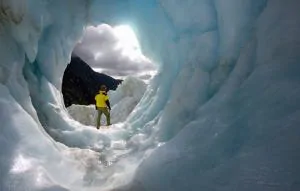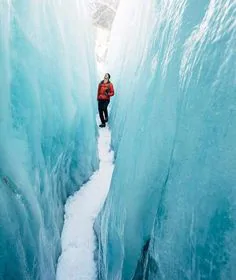Just behind the township of Franz Josef, nestled amongst the majestic Southern Alps, is the mighty Franz Josef Glacier. This enormous river of ice is always present. Whether it’s retreating or advancing, Mother Nature is always at work.
 Franz Joseph’s Frozen Tears
Franz Joseph’s Frozen Tears
Although never in a hurry (the glacier moves around 50cm a day), Franz Josef Glacier is always on the move as it flows from 3,000m to just 240 metres above sea level.
Glaciologists make a study of explaining how the glacier came to be and why it retreats and advances. It’s all about accumulation, ablation, response time, and previous ice ages.
But for Ngai Tahu, the local Māori iwi (tribe) of Westland, there is a much better way to explain this incredible formation amongst the mountains.
And it has to do with a broken heart
Kā Roimata o Hinehukatere (The Frozen Tears of Hinehukatere)
The Māori story of Franz Josef Glacier is about Hinehukatere, an extremely strong and fearless girl who loved climbing in the mountains.
One day she persuaded her lover, Wawe, to climb with her. Wawe was less experienced in the mountains but went along on the climb so that he could be with his beloved. 
Disaster struck when an avalanche swept Wawe down the mountain to his death. Hinehukatere was grief-stricken. After his death, her heart was broken and her tears flowed down the mountainside. The gods froze her tears of aroha (love) in the form of the glacier as a reminder of her grief.
And so the glacier came to have its name, Kā Roimata o Hinehukatere – The Frozen Tears of Hinehukatere.
From a tragic love story, Franz Josef Glacier has gone on to become one of the most popular tourist destinations in New Zealand.
When you visit Glacier Country, make sure you take a walk along the Franz Josef Glacier valley floor alongside the Waiho River. The Waiho River flows directly from the glacier and is Hinehukatere’s broken-hearted tears, still flowing for her lost love.



